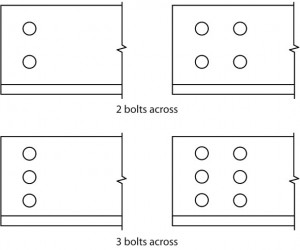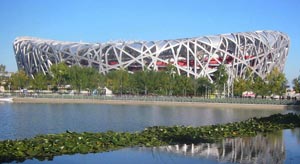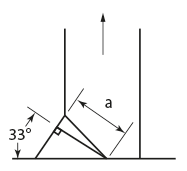Technical
AD 351: Tension resistance of angles in SCI P363
The Advisory Desk has received a number of questions regarding the tension resistance tables provided in the “Eurocode Blue Book” (SCI publication P363) for single angles connected through one leg by welding or bolting. This AD clarifies the basis of the values in P363.
Angles connected with bolts
For Eurocode design, four checks are required for angles connected with bolts:
1. A check of the gross cross section, using the yield strength, fy , as required by clause 6.2.3(2)(a) of BS EN 1993-1-1.
2. A check of the net cross-section through the fastener holes, using the ultimate strength, fu , as required by clause 6.2.3(2)(b) of BS EN 1993-1-1
3. A block tearing check, as required by clause 3.10.2(3) of BS EN 1993-1-8
4. For angles bolted through one leg only, a check of the effective net section, as required by clause 3.10.3(2) of BS EN 1993-1-8
In general, for angles connected by one leg, the ultimate resistance according to check 4 above will govern. Block tearing could be critical, but is unlikely for orthodox connection arrangements.
The Eurocode provisions for check 4 are limited in the arrangement of bolts that they cover. Clause 3.10.3 of BS EN 1993-1-8 only covers the arrangement of a single line of bolts along the length of the angle, as shown in Figure 1. Different rules are presented for 1, 2 and 3 or more bolts.
BS EN 1993-1-8 does not cover the situation when there are two or more bolts across the angle leg, as shown in Figure 2. This arrangement is often used to minimise the size of the connection components, such as the gusset plate.
Since both bolted arrangements were covered by BS 5950-1:2000 (clause 4.6.3.1), it was decided that P363 would adopt the BS 5950 rules for check 4; this is made clear in the explanatory notes. In addition to providing more comprehensive coverage of practical connections, this choice does have some advantages, because the calculated resistance is independent of the spacing of the bolts. Resistances calculated according to BS EN 1993 1 8, 3.10.3 are dependant on the spacing of the bolts.
The BS 5950 rules are not affected by the number of bolts along the member, or the spacing of the bolts. For this reason only the number of bolts across the angle leg needs to be specified – the tables in P363 are applicable to any number of bolts along the angle. Depending on the leg length of the angle, the tables give the tension resistance values for 1, 2 or 3 bolts across the leg of the angle.
Numerical calculations demonstrate that the resistance calculated in accordance with BS EN 1993-1-8, 3.10.3 can be larger or smaller (depending on the spacing of the bolts) than the resistance calculated according to the BS 5950 rules. At reasonable spacings, the resistances are broadly similar. For strict compliance with design to the Eurocodes, the rules in 3.10.3 should be followed for bolts in a single line along the angle.
The lack of coverage in the Eurocode has been brought to the attention of the responsible committee, and there are indications that a rule will be developed for multiple bolts across the angle leg. In the meantime, it is considered that the tension resistances for single angles quoted in P363 are appropriate for design, even though they are based on BS 5950 rules and not strictly in accordance with the Eurocode.
Angles connected by welds
For Eurocode design, for angles connected with welds the governing check is for the resistance of the effective cross sectional area, using the yield strength, fy, as required by BS EN 1993-1-8, clause 4.13. This clause defines effective cross-sectional area for equal and unequal leg angles.
For consistency with the adoption of BS 5950 rules for angles connected by bolts, the resistances for single angles connected by welding to one leg quoted in P363 are also based on BS 5950 rules (clause 4.6.3.1). The resistances based on the BS 5950 rules are conservative when the angle is an equal angle, or is attached by welding to the longer leg of an unequal angle. If the short leg of an unequal angle is attached by welding (an unusual situation), the Eurocode rule may give a lower resistance, depending on the asymmetry of the angle. For strict compliance with the Eurocode, the rules in BS EN 1993-1-8, clause 4.13 should be followed for unequal angles connected by welding to the short leg.
Contact: Abdul Malik
Tel: 01344 636525
Email: advisory@steel-sci.com














